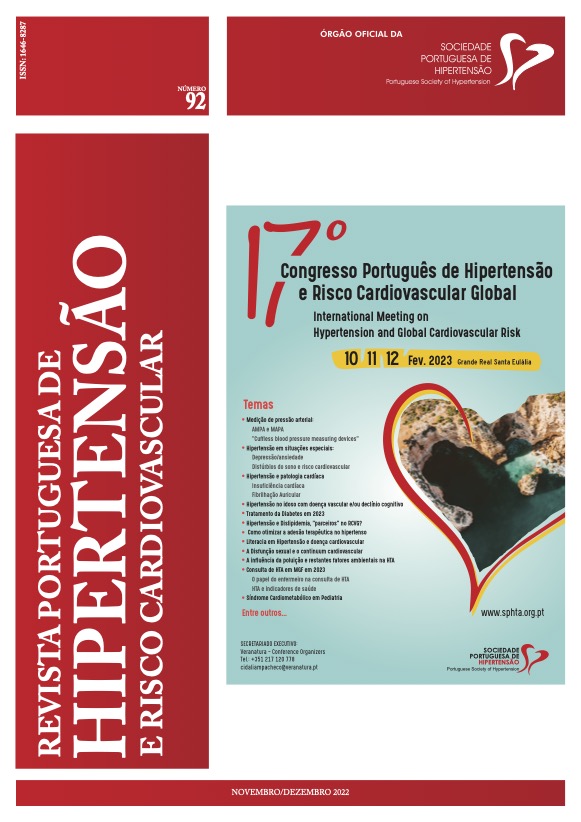ATHEROMATOUS DISEASE IN INDIVIDUALS WITH DYSLIPIDEMIA ASSESSED BY TRIPLEX CERVICAL SCAN
DOI:
https://doi.org/10.58043/rphrc.57Keywords:
Cardiovascular Diseases, risk factors, aterosclerosis, Triplex cervical scanAbstract
Introduction: Cardiovascular diseases are a high risk of mortality in the population and are inherent to several factors. The main responsible for this disease is atherosclerosis, is due to different risk factors such as dyslipidemia, hypertension, obesity, age, gender, among others. For diagnosis and evaluation of carotid atherosclerosis there are tests such as Triplex Cervical Scan.
Methods: The sample consists of 569 individuals, who performed Triplex Cervical Scan in 2019, at the Laboratory of Cardiac and Neurovascular Ultrasound, located at the Hospital do Espírito Santo, in Évora.
Results: The sample included 569 individuals, with a mean age of 78 years. The most prevalent cardiovascular risk factors were HTA and dyslipidemia. In the relationship between dyslipidemia and increased severity of the degree of stenosis, statistical significance was proven between the risk factor dyslipidemia with the right carotid axis and the left vertebral artery. Of the individuals with dyslipidemia at the level of the left carotid axis, 25.8% had carotid atherosclerosis without hemodynamic repercussion. Regarding the statistical significance between cardiovascular risk factors and the presence of atherosclerosis with a higher degree of severity, only correlation with the age factor was proven.
Discussion: In the study sample, most individuals present several cardiovascular risk factors, and the highest prevalence was recorded in hypertension and dyslipidemia, since they exist in more than half of the sample population.
Conclusion: With the present study, it is possible to conclude that in this sample there is a prevalence of several risk factors in individuals with iim values above normal. The age factor that proved to be quite influential in the presence of atherosclerosis. Of the individuals with dyslipidemia more than half have atherosclerosis, at its earliest stage.
Downloads
References
Faludi A, Izar M, Saraiva J, Chacra A, Bianco H, Afiune Neto A, et al. Atualização Da Diretriz Brasileira De Dislipidemias E Prevenção Da Aterosclerose - 2017. Arq Bras Cardiol. 2017;109(1).
Luisada A. Doenças cardio-vasculares. Am Heart J. 2016;37(3):475.
Sposito AC, Caramelli B, Fonseca FAH, Bertolami MC, Rassi A, Neto AA, et al. IV Diretriz Brasileira sobre dislipidemias e prevenção da aterosclerose Departamento de Aterosclerose da Sociedade Brasileira de Cardiologia. Arq Bras Cardiol. 2007;88(SUPPL. 1):2–19.
Mach F, Baigent C, Catapano AL, Koskinas KC, Casula M, Badimon L, et al. 2019 ESC/EAS Guidelines for the management of dyslipidaemias: lipid modification to reduce cardiovascular risk. Eur Heart J. 2019;1–78.
ARAÚJO SMM. Caracterização Morfológica das Placas Ateroscleróticas Carotídeas. Artigos Cetrus. 2014;1–19.
Naylor AR, Ricco JB, de Borst GJ, Debus S, de Haro J, Halliday A, et al. Management of Atherosclerotic Carotid and Vertebral Artery Disease: 2017 Clinical Practice Guidelines of the European Society for Vascular Surgery (ESVS). Eur J Vasc Endovasc Surg [Internet]. 2018;55(1):3–81. Available from: https://doi. org/10.1016/j.ejvs.2017.06.021
Von Reutern GM, Goertler MW, Bornstein NM, Sette M Del, Evans DH, Hetzel A, et al. Grading carotid stenosis using ultrasonic methods. Stroke. 2012;43(3):916–21.
APTEC - Associação Portuguesa de Cardiopneumologistas [Internet]. APTEC. 2019 [cited 2020 Jul 9]. Available from: http://www.aptec. pt/paginas/aptec/cardiopneumologia/areas-de- intervencao/ultrassonografia-vascular.php
De Freitas P, Piccinato CE, Martins WDP, Mauad Filho F. Carotid atherosclerosis evaluated by Doppler ultrasound: Association with risk factors and systemic arterial disease. J Vasc Bras. 2008;7(4):298–307.
Wang R, Nascimento BR, Neuenschwander FC. Aterosclerose e Inflamação: Ainda Muito Caminho a Percorrer. Arq Bras Cardiol. 2020;114(4):699–700.
Cérebro-Cardiovasculares PN para as D. Para As Doenças Cérebro-Cardiovasculares. 2017.
Hurtubise J, McLellan K, Durr K, Onasanya O, Nwabuko D, Ndisang JF. The different facets of dyslipidemia and hypertension in atherosclerosis. Curr Atheroscler Rep [Internet]. 2016;18(12). Available from: http://dx.doi.org/10.1007/s11883-016-0632-z
Galkina E et al. Immune and Inflamatory Mechanisms of Atherosclerosis. NIH Public Access [Internet]. 2009;27(1):1–43. Available from: https:// www.ncbi.nlm.nih.gov/pmc/articles/PMC3624763/ pdf/nihms412728.pdf
Lopes T, Alves A, Pereira A. Avaliacao da prevalencia ESALD.pdf. Associação Portuguesa de Cardiopneumologistas [Internet]. 2015 Feb;40–7. Available from: http://hdl.handle.net/10400.11/2816





